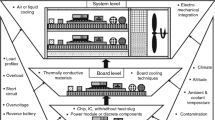Abstract
Within the electronics industry, high degree of integration and enhanced performance has led to high heat dissipation electronic devices. This has identified the future development of very high heat flux components. In this paper, a novel and high efficient diffusion welded heat fin-plate radiator (HFPR) was proposed and designed. Various parameters affect the thermal performance of HFPR. The effect of three parameters: the working fluid filling ratios (8% < FR < 70%), the vacuum degrees (0.001 Pa < VD < 0.1 Pa), and the air flow velocities (0.5 m/s < u < 6 m/s) were investigated experimentally. Using distilled water and ethanol as working fluids, a series of tests were carried out to find the influence of the above parameters on steady-state heat transfer characteristics of HFPR. The experimental results indicated that the filling ratio and vacuum degree had a significant influence on thermal performance of HFPR. Also compared with cooling performance using distilled water and ethanol, the HFPR cooling component using distilled water had a stronger heat dissipation capacity for the same filling ratio. The results also can provide a basis for optimal design of HFPR structure.










Similar content being viewed by others
Abbreviations
- D e :
-
Hydraulic diameter (m)
- FR:
-
Filling ratio
- F s :
-
Front surface area (m2)
- dP :
-
Pressure loss (Pa)
- Q :
-
Heat load (W)
- R :
-
Resistance (Ω)
- T :
-
Temperature (K)
- U :
-
Voltage (V)
- VD:
-
Vacuum degree
- c p :
-
Specific heat (J/kg K)
- h f :
-
Fin height (m)
- m :
-
Mass flow rate (kg/s)
- u :
-
Air flow velocity (m/s)
- s f :
-
Fin pitch (m)
- Δt :
-
Temperature difference (K)
- δ :
-
Distance between temperature measuring points and front surface of heater (m)
- δ f :
-
Fin thickness (m)
- λ :
-
Thermal conductivity (W/m K)
- as:
-
Air side
- fs:
-
Front surface
- in:
-
Air inlet
- m:
-
Measure
- out:
-
Air outlet
- s:
-
Source
References
Womac DJ, Ramadhyani S, Incropera FP (1993) Correlating equations for impingement cooling of small heat sources with single circular liquid jets. J Heat Transf Trans ASME 115:106–115
Bintoro JS, Akbarzadeh A, Mochizuki M (2005) A closed-loop electronics cooling by implementing single phase impinging jet and mini channels heat exchanger. Appl Therm Eng 25:2740–2753
Wadsworth DC, Mudawar I (1992) Enhancement of single-phase heat transfer and critical heat flux from an ultra-high-flux simulated microelectronic heat source to a rectangular impinging jet of dielectric liquid, J. Heat Transf Trans ASME 114:764–768
Pautsch AG, Shedd TA (2005) Spray impingement cooling with single- and multiple-nozzle arrays. Part I: heat transfer data using FC-72. Int J Heat Mass Transf 48(15):3167–3175
Horacek B, Kiger KT, KimSingle J (2005) nozzle spray cooling heat transfer mechanisms. Int J Heat Mass Transf 48(8):1425–1438
Vafai K, Zhu L (1999) Analysis of two-layered micro-channel heat sink concept in electronic cooling. Int J Heat Mass Transf 42:2287–2297
Weisberg A, Bau HH, Zemel J (1992) Analysis of micro-channels for integrated cooling. Int J Heat Mass Transf 35:2465–2474
Kulkarni DP, Das DK (2005) Analytical and numerical studies on microscale heat sinks for electronic applications. Appl Therm Eng 25:2432–2449
Chi HN, Groll M, Van Th D (1979) Experimental investigation of closed two-phase thermosyphons. In: AIAA 14th thermophysics conference, Orlando, Florida, 4–6 June 1979, pp 239–246
Khodabandeh R (2004) Thermal performance of a closed advanced two-phase thermosyphon loop for cooling of radio base stations at different operating conditions. Appl Therm Eng 24:2643–2655
Khodabandeh R, Palm B (2002) Influence of system pressure on the boiling heat transfer coefficient in a closed two-phase thermosyphon loop. Int J Therm Sci 41:619–624
Mudawar I (2000) Assessment of high-heat-flux thermal management schemes. In: Itherm 2000 Proceedings, vol 1, Las Vegas, USA, May 2000, pp 1–20
Lin L, Faghri A (1997) Steady-state performance in a thermosyphon with tube separator. Appl Therm Eng 17(7):667–679
Lee Y, Rhi S, Kim W (1997) Simulation of cooling systems using two-phase closed thermosyphons for telecommunication multi-chip modules. In: 5th International heat pipe symposium. Pergamon Press, Melbourne
Ghiaasian SM, Wu X, Sadowski DL, Abdel-Khalik SI (1997) Hydrodynamic characteristics of counter-current two-phase flow in vertical and inclined channels: effects of liquid properties. Int J Multiphase Flow 23(6):1063–1083
Lin L, Faghri A (1998) An analysis of two-phase flow stability in a thermosyphon with tube separator. Appl Therm Eng 18(6):441–455
Ong KS, Haider MD, Alalhi E (1999) Experimental investigation on the hysteresis effect in vertical two-phase closed thermosyphons. Appl Therm Eng 19:399–408
Payakaruk T, Terdtoon P, Ritthidech S (2000) Correlation to predict heat transfer characteristics of an inclined closed two-phase thermosyphon at normal operating conditions. Appl Therm Eng 20:781–790
Abou-Ziyan HZ, Helali A, Fatouh M, Abo El-Naser MM (2001) Performance of stationary and vibrated thermosyphon working with water and R134a. Appl Therm Eng 21:813–830
Bojic M, Lukic N (2002) Controlling evaporative three finger thermosyphon. Energy Convers Manage 43:709–720
Acknowledgments
The authors acknowledge the financial support provided by funds of the program for new century excellent talents in University (Grant no. NCET-07-0434) and the Doctorate Foundation of Nanjing University of Technology (Grant no. BSCX200714).
Author information
Authors and Affiliations
Corresponding author
Rights and permissions
About this article
Cite this article
Peng, H., Ling, X. Experimental investigation on flow and heat transfer performance of a novel heat fin-plate radiator for electronic cooling. Heat Mass Transfer 45, 1575–1581 (2009). https://doi.org/10.1007/s00231-009-0532-7
Received:
Accepted:
Published:
Issue Date:
DOI: https://doi.org/10.1007/s00231-009-0532-7




